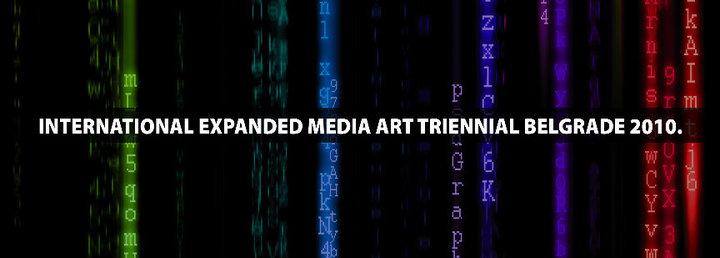International Triennial of Expanded Artistic Media
Belgrade, 5th of August – 20th of September 2010
After the first Fluxus festival in Wiesbaden in 1962 and the exciting transformation of the contemporary art on planetary scale, the odyssey of expanded artistic media began by publication of Fluxus Expanded Arts Diagram and Diagram of Historical Development of Fluxus and all the other four dimensional, sonic, optical, smelling and tactile artistic forms of George Maciunas in 1973, where among other things one can find the notion of expanded cinema, which made Mr. Bozidar Zečević, a Serbian film critic, introduce this notion and expanded artistic media to this country.
In the very begining, in 1974, during the third April Meeting of Students in Student Cultural Center of Belgrade, when the contest for works of expanded artistic media was announced, there already were various understandings and interpretations of this phenomenon. Thus, Biljana Tomic, while writing about the assumptions of total art gave three definitions of expanded media: 1) expanded media as expansion of artistic language 2) expanded media – art in function of art and 3) expanded media – towards the total art. Matko Mestrovic writes about a catalytical interaction, as well as phenomena of artistic interventions and conceptions that cause „unpredictable reactions in a social space“ as Bozidar Zecevic writes about the notion of game, namely the rennaisance of game and new forms of consciousness, and he elaborates these thesis in an article on radical evolution in all areas. Jesa Denegri writes about possibilities of formation of new approaches to art, that could in a further stream of development lead to global change of substantial phisionomy of art, when an artist will use the widest possible register of expressive techniques, disregarding the boundaries of a format and material, in communication with the audience he/she will count on activation of all mental and sensual capabilities of people. Probably the furthest analysys belongs to Vladan Radovanovic, who studies the relation between artistic media, their collision and interaction having in mind the research and discovering of new aesthetical possibilities of shaping of environment in accordance with the level of science and technology – suggesting the removal of borders between arts, but also between art and users, advocating the unity of expandable and expanded.
It took a decade since then to form the Expanded Media Section within the Association of Visual Artists of Serbia (ULUS) following the concept of Cedomir Vasic, as simultaneously in Zagreb a specific gallery named Expanded Artistic Media Space began to work under auspices of HDLUZ.
Since the 1970’s and the millenium switch in contemporary art, many important changes took place, art evolved in many ways and the process of desacralization of artistic expressions and forms and defetishization of not just art but also the artists themselves is still in progress. The Trienial is the meeting point of old and new artistic tendencies, the departing and upcoming actors of contemporary artistic practice. The Trienial invited protagonists of historical avantgardes and neoavantgardes, begining with futurism, DADA, surrealism, Fluxus, situationism, action and combined painting, pop art, conceptual art and contextualism untill the ones who bear the new tendencies and media like electronic and interactive art, experimental poetry, retrofuturism and neoism, cinetic art, cyber and web art, digital art, video art, performance, mail art... However, it does not mean that the concept of the Trienial includes and favors just the evolution of contemporary artistic forms with no regards to content of artistic works. Therefore, the issue is not about formalism par excellence or the idolatry of artistic forms, „which is the real soul of each avantgardism“ (Galvano della Volpe) but the concept assumes the OPEN MIND of artists and the OPEN WORLD, not only for the matter of artistic media.
Although it sounds like antiutopia, our aim is to show that the Trienial demonstrates not only the transfiguration of modern art as an OPEN PROCESS, but it questions the transfiguration of the entire World into a more human and more tollerant world compared to the one that we have known so far. In relation to the so called consumers of art, the ordinary people as we experience them, art should not any longer be a corpus mysticum of a tiny stylistic drills, estranged and non-understandable activity of the chosen few, it should exit not just the gallery and museum spaces but to achieve other aims and intentions of contemporary artists, such as for example, the removal of hardly bearable dychotomy LIFE-ART.
Dobrica Kamperelic







Commenti 0
Inserisci commento